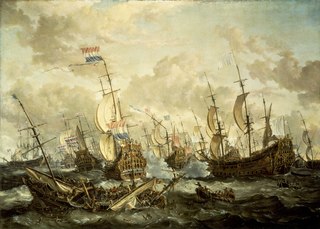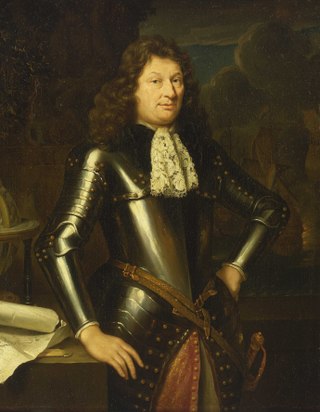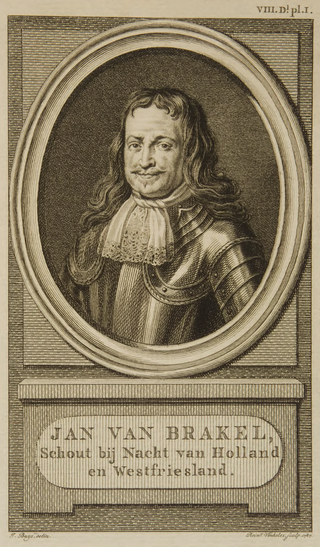Related Research Articles

The Four Days' Battle was a naval engagement fought from 11 to 14 June 1666 during the Second Anglo-Dutch War. It began off the Flemish coast and ended near the English coast, and remains one of the longest naval battles in history.

Michiel Adriaenszoon de Ruyter was a Dutch admiral. His achievements with the Dutch Navy during the Anglo-Dutch Wars earned him the reputation as one of the most skilled naval commanders in history.

The naval Battle of Texel or Battle of Kijkduin took place off the western coast of the island of Texel on 21 August 1673 between the Dutch and the combined English and French fleets. It was the last major battle of the Third Anglo-Dutch War, which was itself part of the Franco-Dutch War (1672–1678), during which Louis XIV of France invaded the Republic and sought to establish control over the Spanish Netherlands. English involvement came about because of the Treaty of Dover, secretly concluded by Charles II of England, and which was highly unpopular with the English Parliament.

Cornelis Maartenszoon Tromp, Count of Sølvesborg was a Dutch naval officer who served as lieutenant-admiral general in the Dutch Navy, and briefly as a general admiral in the Royal Danish-Norwegian Navy. Tromp fought in the Anglo-Dutch Wars and the Scanian War. His father was the renown Lieutenant Admiral Maarten Tromp.

The naval Battle of Solebay took place on 28 May Old Style, 7 June New Style 1672 and was the first naval battle of the Third Anglo-Dutch War.

The Battle of Lowestoft took place on 13 June [O.S. 3 June] 1665 during the Second Anglo-Dutch War. A fleet of more than a hundred ships of the United Provinces commanded by Lieutenant-Admiral Jacob van Wassenaer, Lord Obdam, attacked an English fleet of equal size commanded by James, Duke of York, forty miles east of the port of Lowestoft in Suffolk.

Philips van Almonde was a Dutch Lieutenant Admiral, who served in his nation's maritime conflicts of the 17th and early 18th centuries.

The Battles of Schooneveld were two naval battles of the Franco-Dutch War, fought off the coast of the Netherlands on 7 June and 14 June 1673 between an allied Anglo-French fleet commanded by Prince Rupert of the Rhine on his flagship the Royal Charles, and the fleet of the United Provinces, commanded by Michiel de Ruyter.

Jacob, Banner Lord of Wassenaer, Lord Obdam, Hensbroek, Spanbroek, Opmeer, Zuidwijk and Kernhem was a Dutch nobleman who became lieutenant admiral, and supreme commander of the navy of the Dutch Republic. The name Obdam was then also spelled as Opdam. British contemporaneous sources typically refer to him as Admiral Opdam or Lord Obdam because it was not until 1657 that he bought the Wassenaar Estate from relatives and thus acquired its title. Modern Dutch sources sometimes less correctly insert a second "van" between "Wassenaer" and "Obdam" or use the modern spelling "Wassenaar".

Jan van Brakel was a Dutch rear admiral who distinguished himself on many occasions during the Second and Third Anglo-Dutch wars and the Nine Years War.

Willem van der Zaan was a Dutch Admiral. His name is often given in the 17th century spelling Zaen.

The St James' Day Battle took place on 25 July 1666, during the Second Anglo-Dutch War. It was fought between an English fleet commanded jointly by Prince Rupert of the Rhine and George Monck, and a Dutch force under Lieutenant-Admiral Michiel de Ruyter.

Adriaen van Trappen Banckert was a Dutch admiral. In English literature he is sometimes known as Banckers. His first name is often rendered in the modern spelling Adriaan. Van Trappen was the original family name, but the family was also and better known under the name of Banckert. In the 17th century Netherlands such a situation was solved by combining the two names.

Abraham van der Hulst was a Dutch admiral in the 17th century.

Engel Michielszoon de Ruyter was a Dutch vice-admiral.

Willem Joseph baron van Ghent tot Drakenburgh was a 17th-century Dutch admiral. His surname is also sometimes rendered Gendt or Gent; he was the first commander of the Dutch marines.

Enno Doedes Star was a Dutch admiral.

Admiral Sir John Harman was an English officer of the Royal Navy, who served first under the Commonwealth, then Charles II following the 1660 Stuart Restoration.

The Dutch States Navy was the navy of the Dutch Republic from 1588 to 1795. Coming into existence during the Eighty Years' War, the States Navy played a major role in expanding and protecting the Dutch colonial empire, in addition to participating in numerous conflicts with rival European powers. The States Navy consisted of five admiralties, which were respectively based in Amsterdam, Friesland, the Noorderkwartier, Rotterdam and Zeeland. This organisational structure contributed to the decentralised nature of the States Navy, which heavily relied upon privateers and armed merchantmen in times of war.
References
- ↑ Bruijn, J. R. (1966). De Oorlogvoering ter zee in 1673 in Journalen en andere Stukken. Groningen. p. 235.
{{cite book}}: CS1 maint: location missing publisher (link) - 1 2 3 4 Brand, Hanno (2005). Trade, Diplomacy and Cultural Exchange: Continuity and change in the North Sea area and the Baltic c. 1350-1750. Uitgeverij Verloren. ISBN 9065508813 . Retrieved 2019-07-16.
- ↑ Japp R. Bruijn, Ronald Prud'homme van Reine and Rolof van Hovell tot Westerflier, ed. (2011). DeRuyter: Dutch Admiral. Karwansaray Publishers.
- ↑ Bender, James (2014). Dutch Warships in the Age of Sail, 1600-1714: Design, Construction, Careers, and Fates. Naval Institute Press. ISBN 978-1848321571.
3. The Dutch Navy of the Seventeenth and Eighteenth Centuries by Jaap R. Bruijn